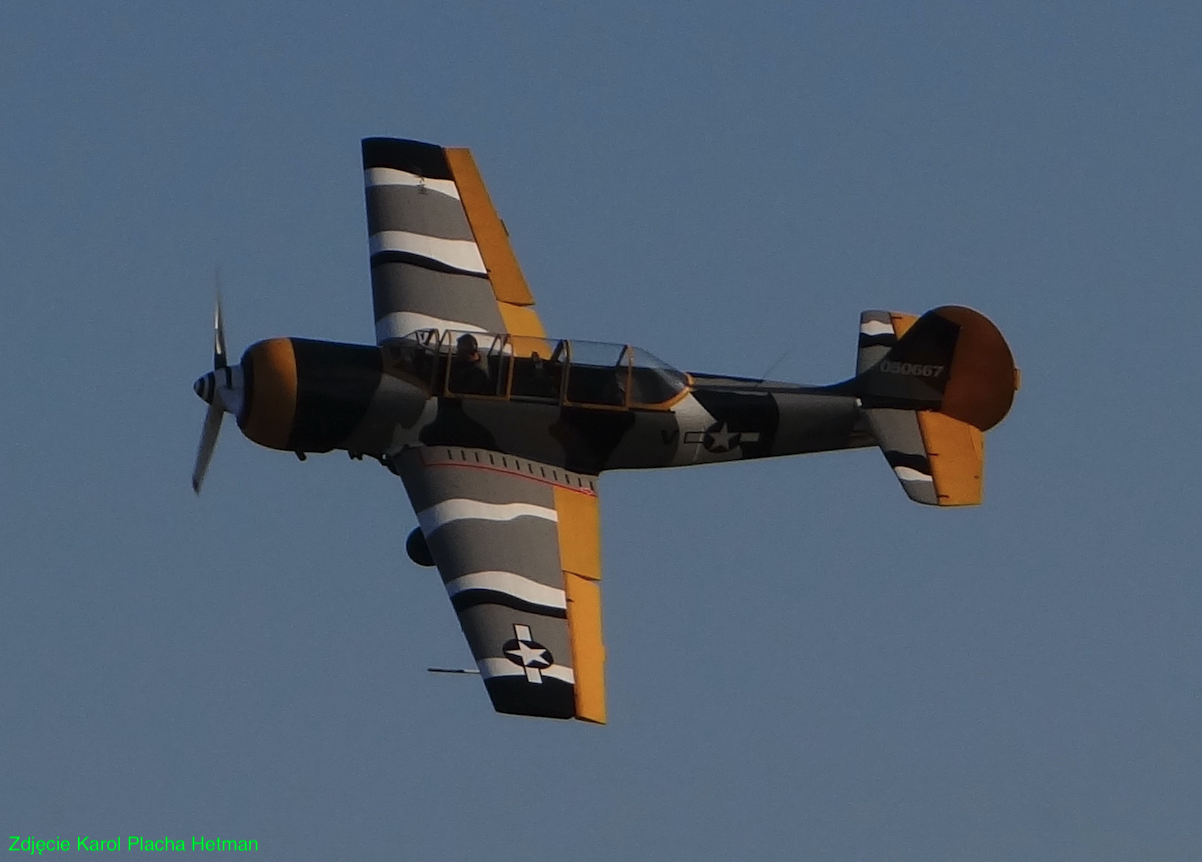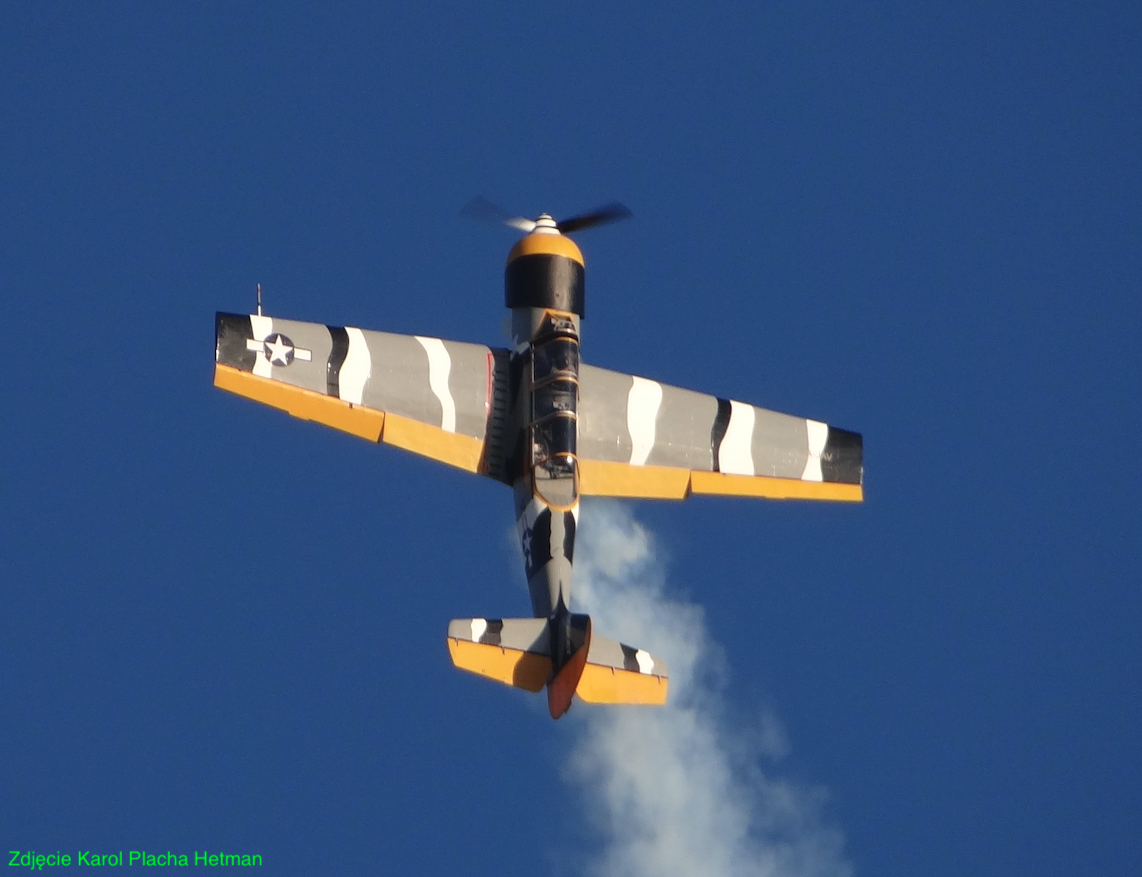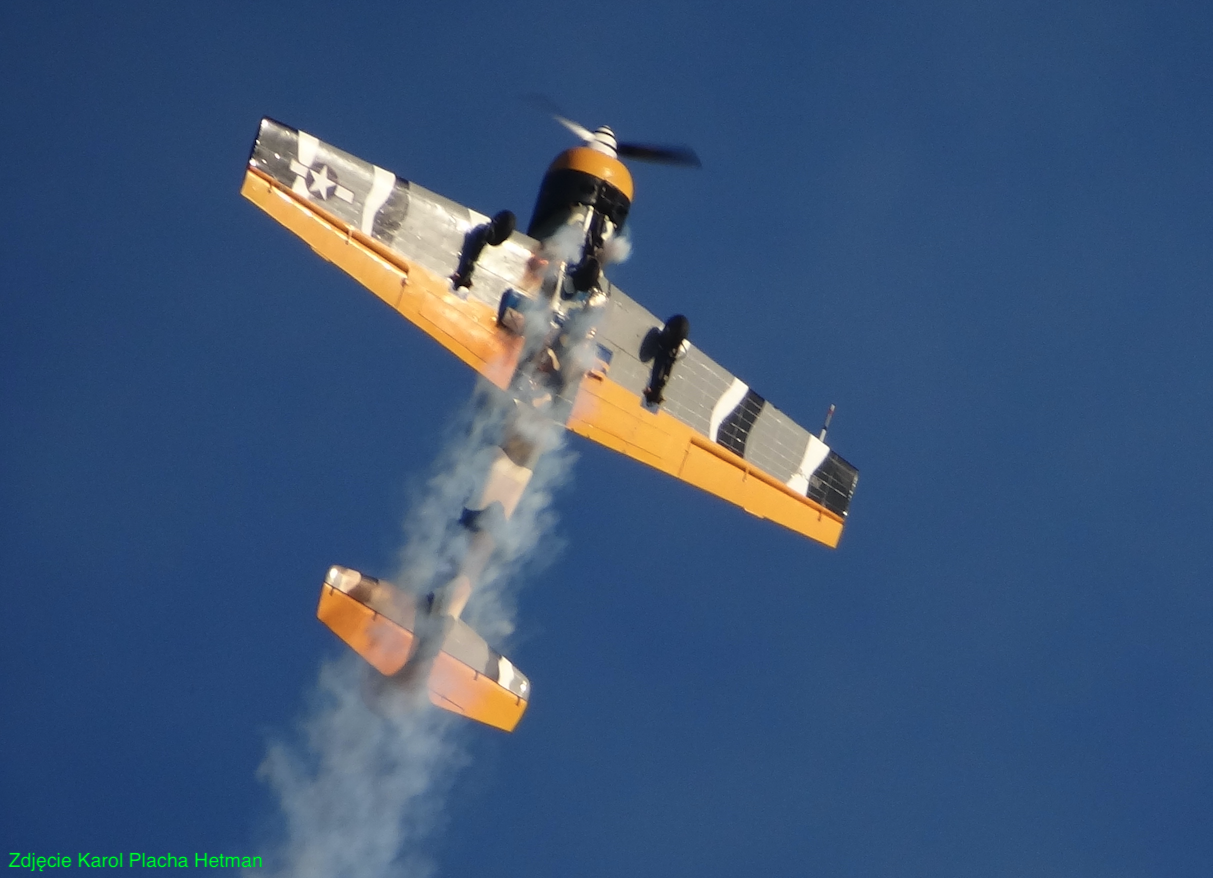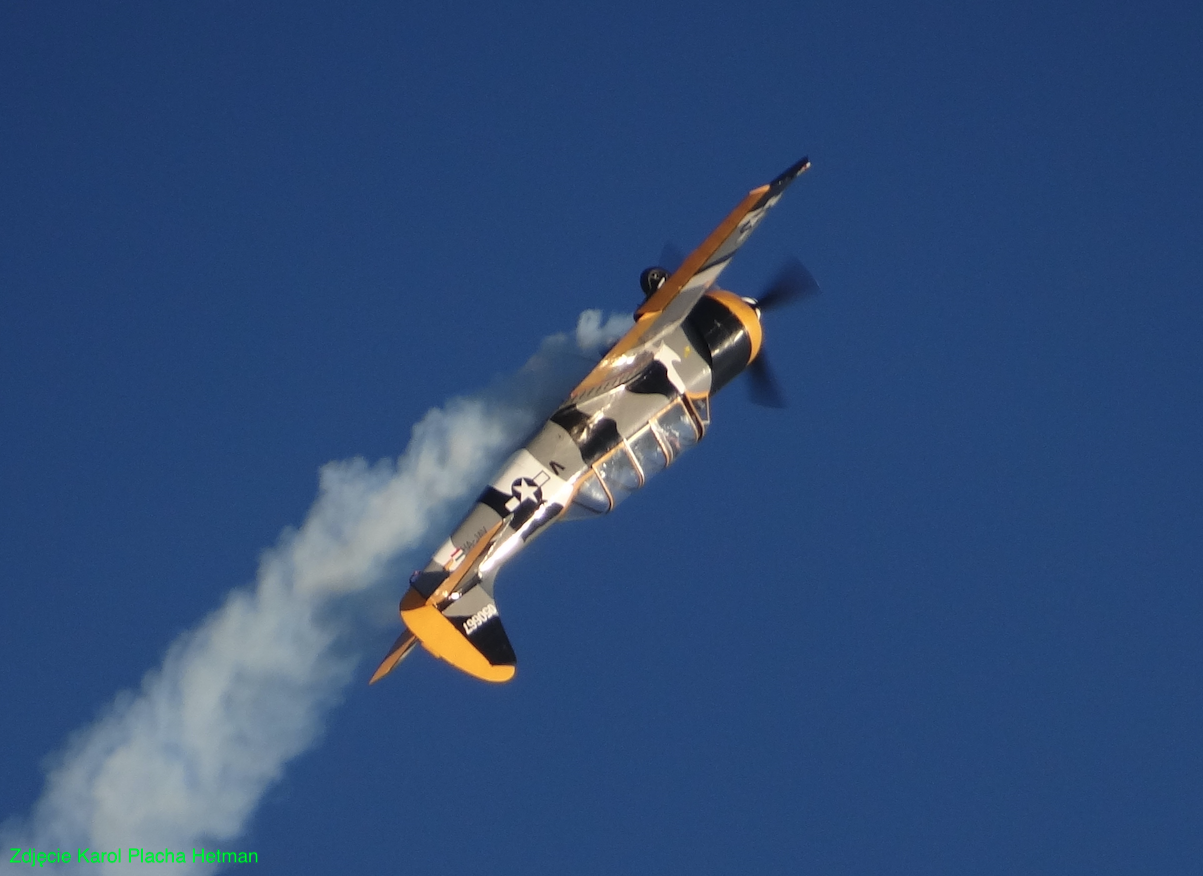Nowy Targ 2023-07-14
Yakovlev Yak-52 HA-JAV.
Aerobatic aircraft Yak-52 registration HA-JAV, serial number 856008, is registered in Hungary. The aircraft was built in 1985. M-14P engine. It was based at Szeged Airport (LHUD). Still in 2022, the plane was painted blue with yellow elements. The plane joined the Slovak aviation demonstration group Retro Sky Team. In 2023, the aircraft received a new painting, camouflage; black, grey, white with yellow elements. The airframe features US military identification marks. The tail number is 050667. The Hungarian flag and HA-JAV registrations have been left.





Yakovlev Yak-18 aerobatic.
In the CCCP, the first aircraft that was suitable for aerobatics was the Yakovlev Yak-18 in version A (Aerobatic). The Yak-18 A aircraft was built in 1957, when the Yak-18 airframe was equipped with the AI-14 R engine. hp). The engine has a volume of 10.16 liters. The compression ratio is 5.9:1. The diameter of the motor is 0.985 m. The length of the motor is 0.956 m.
Yak-50.
In 1971, the Yak-18 T aircraft was developed, which was powered by the Vedeneniev M-14 engine, with a power of 221 kW (300 hp). On the basis of this aircraft, a typical aerobatic aircraft was developed, which was designated Jak-50. The requirements for the aircraft were developed by the DOSAAF organization. The Yak-50 made its first flight in 1974. After some time, the aircraft received the M-14 P engine, with a power of 265 kW (360 hp). The Yak-50 aircraft was the work of young designers led by Aleksander Aleksandrowicz Yakovlev, son of the famous designer Aleksandr Siergiejewicz Yakovlew, who supervised the entire program. Aleksandr Sergeyevich Yakovlev (1906-1989) had three children: sons Alexander and Vladimir, and daughter Elena.
When designing the Yak-50 aircraft, attention was paid to the strength of the airframe as well as stability and controllability. Manufacturing and production methods were also analysed. The main method of connecting airframe elements is riveting, but gluing and welding have also been used. The aircraft's strong point was its 265 kW (360 hp) Vedenev M-14 P engine.
The Jak-50 aircraft turned out to be a successful aerobatic aircraft. The airframe withstands overloads from +7g to -5g and can perform "barrels" at a speed of up to 180 degrees per second. In 1976, at a competition in Kiev, the Yak-50 aircraft outclassed rivals from socialist countries. Pilots (women and men) from CCCP won 7 medals. In August 1982, Russian W. Smolin won the gold medal at the XI World Championships in Austria. Also as a team, the Russians won gold medals (men and women).
Yak-52.
The next aircraft, marked Jak-52, was a development of the Jak-50 aircraft. The construction work progressed very quickly and the prototype was ready in 12 months. The prototype of the Yak-52 aircraft was flown in 1976. Serial production was started in Romania at the Aerostar plant.
Unlike the Yak-50, the new Yak-52 aircraft received a double cabin in a tandem arrangement. To improve visibility from the cabin, the aircraft received a three-support landing gear with a front wheel. Despite resigning from the aircraft's aerobatic features, the Yak-52 performs full aerobatics, like its predecessor.
In 2012, 9 Jak-52 aircraft were entered into the register of Polish aircraft. In 2013, there were 13 aircraft in the register with registration marks SP-YDD, SP-YDE, SP-YDG, SP-YDH, SP-YDN, SP-YDO, SP-YDT, SP-YDU, SP-YFC , SP-YFG, SP-YLB, SP-YNH, SP-YUH. In 2015, another 8 aircraft were registered, so that at the end of that year there were already 34 Yak-52 aircraft in Poland. In January 2019, there were 51 Yak-52 aircraft in the register. The planes are mainly of Romanian production.
Yak-55.
In 1982, the new Jak-55 aerobatic aircraft was flown. In the same year (1982), the prototype Yak-55 took part in the World Championships in Austria, but was not successful at that time. The aircraft has a changed layout from low-wing to mid-wing. The cabin is for one person, covered with a drip fairing, which is moved back. The hull has been lengthened. The landing gear is three-support, fixed, with a tail wheel. The main landing gear is single-leg with spring suspension. The wheels of the main landing gear were reduced in size and provided with fairings. The construction of the Yak-55 aircraft withstands overload from +9g to -9g.
Yak-55 is an aerobatic, single-seater aircraft, built in a classic layout, all metal. The structure of the aircraft withstands overloads from +9g to -9g. The single-girder leaf has a symmetrical profile with a thickness of 18%. The wings are equipped with one-piece flaperons, with balancing flaps that cover 75% of the trailing edge. The wing has no rise. The cabin is for one person, covered with a drip fairing, which is moved back. In addition, small windows have been placed in the lower part of the cockpit to improve the pilot's view of the ground.
The Jak-55 aircraft uses smaller wheels, measuring 350 mm x 135 mm. The track of the main undercarriage is 2.00 m. Access to the engine is very easy. The engine cover is folded in the form of two halves to the sides.
Construction.
Yak-50 is an aerobatic, single-seater aircraft, built in a classic layout, all metal. The structure of the aircraft withstands overloads from +9g to -6g. Jak-50 and Jak-55 aerobatic aircraft have one main fuel tank with a capacity of 55 liters or 50 liters.
Yak-52 is a multi-role, two-seat aircraft, built in a classic layout, all metal.
Trapezoidal wings are mounted to the fuselage at the bottom (low wing). The Yak-55 is a medium-wing aircraft. Single-girder structure with working roofing. The duralumin sheet covering is made of sheets of various thicknesses. Clark UH profile used. The thickness of the profile at the fuselage is 14.5% and 9% at the tip of the wing. Equipped with take-off and landing flaps and ailerons. The fuel tanks are located in the nose section, the oil cooler and the battery in the middle section. The ailerons are slotted with axial compensation and mass equipment. In the area of the center wing, there is an oil cooler, battery and main landing gear mounting points.
The fuselage of the aircraft is semi-monocoque, it consists of 20 duralumin frames and 14 stringers. The three frames are reinforced and the wings are attached to them. The thickness of the duralumin sheet of the cover is 0.6 mm, 1.0 mm and 1.5 mm. Cabins covered.
The tail is classic with a division into rudders and fins. The horizontal and vertical tail is of a single-girder structure.
Chassis.
The chassis is three-support. Oil-gas shock absorbers were used. Pneumatics adapted to operation on airports with ground surface (grass) were used. The Yak-50 has retractable main wheels and a fixed rear tailwheel. The Yak-52 has a front support and all wheels are retractable. The nose landing gear is retracted back into the fuselage. The main landing gear is retracted forward into the wings. The Yak-55 has a fixed main landing gear supplemented with a fixed tail wheel. All wheels have brakes and suspension. The brakes are pneumatic.
Engine.
The aircraft is powered by a Wiedeneniew M-14 P piston engine with a power of 265 kW (360 hp). The engine is a 9-cylinder star with a supercharger. The compressor is centrifugal type. The engine propels the 2-blade propeller with variable pitch. Propeller type V-53 OTA D-35, diameter 2.35 m. The propeller can be equipped with a spinner.
The fuel system enables full aerobatics and inverted flight. The fuel tank with a capacity of 2 x 65 liters (in the Jak-52 aircraft) is mounted in the fuselage in the area of the center wing. The Yak-50 and Yak-55 aircraft have one fuel tank with a capacity of 50 or 55 liters. The service tank is located in the hull next to the engine and has a capacity of 5.5 liters. It is this tank that ensures the engine operation in inverted flight and a two-minute flight with negative g-forces. In the fuselage it is possible to mount an additional tank to increase the range of the aircraft. Then the plane has a range of up to 500 km. In front of the engine there are movable shutters with which the engine temperature is regulated.
Equipment and installations.
Pilots have at their disposal basic pilotage and navigation instruments: artificial horizon, magnetic compass, altimeter, speedometer, accelerometer. The equipment includes a VHF communication radio station type "Ziablik" or "Łandysz-5". Some aircraft were equipped with the Soviet GMK-1A heading system.
The aircraft has a pneumatic system, which is not a common solution in this type of aircraft. There is a main and emergency installation. It is used to start the engine and retract the landing gear, brake the wheels and move the wing flaps. Each system is powered from a separate cylinder.
The 28 V DC electrical installation is powered by a 2 kW generator. There is a battery in reserve.
The aircraft are equipped with a stall warning system. When 10-15 km/h remains to the stall speed, a flag will move on the leading edge of the wing, which will activate the electrical circuit. In the cockpit, a red lamp will light up on the instrument panel and a buzzer will sound.
The training version of the Yak-52 has a device in the instructor's cockpit to simulate various failures of the piloting and navigational instruments.
Jak-50, Jak-52, Jak-55 aircraft are adapted to operate in temperatures from -45 degrees C to +55 degrees C. Some aircraft have been adapted to tow gliders.
Yak-55 T-T data:
Span 8.20 m. Length 7.48 m. Height 2.00 m. Carrying capacity 14.3 m2. curb weight 840 kg. Top speed 320 km/h. Climb speed 16 m/s. 150 m inrun to take. 200 m inrun for landing.
Written by Karol Placha Hetman
